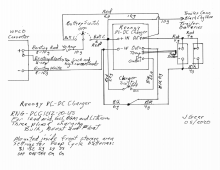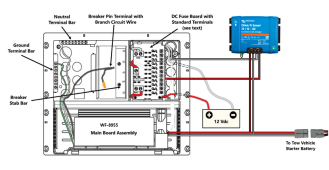0rion
New Member
Hello, I have a 23' travel trailer and have been preparing it for boondocking - a 200w solar suitcase and Victron shunt, MPPT, and inverter with a 100ah Lead Acid Marine battery for now (hope to get 2x GC2's or Lifepo4 soon). We're light power users.
I'm wondering if it's possible to use a DC-DC charger a bit differently. We leave home fully charged so I'm less concerned about charging the house battery when driving - is it possible to connect the DC-DC to the truck battery only when needed to top off the batteries if the solar can't keep up (basically in lieu of having a generator)? So rather than a hardwired line in the truck, a temporary wire I could connect via Anderson plug or battery clamps as needed?
Also, my trailer has the stock WFCO 8955 converter that is known for only staying in absorption mode, which makes me concerned for the health of my lead acid battery, and any future 6v pair or Lithium. Could we not just use the same DC-DC charger here as well, to regulate the converter output into something healthier for the house batteries (basically in lieu of purchasing a better quality converter like Progressive Dynamics)?
TL;DR:
When connected to shore power, existing converter feeds DC-DC, which takes better care of the battery (battery chemistry agnostic).
When boondocking, can connect the tow vehicle to DC-DC to top up the charge when solar can't keep up. Saves the cost of buying a generator, gas, upkeep, etc.
The only downside I see would be the inefficiency of the DC-DC while on shore, but I'd be willing to lose some efficiency if it means a healthier, smarter charge for the battery. Has anybody done this? It just makes so much sense to me, one DC-DC charger could replace a generator and an upgraded converter. I must be missing something...
EDIT - proposed schematic diagram added below.
I'm wondering if it's possible to use a DC-DC charger a bit differently. We leave home fully charged so I'm less concerned about charging the house battery when driving - is it possible to connect the DC-DC to the truck battery only when needed to top off the batteries if the solar can't keep up (basically in lieu of having a generator)? So rather than a hardwired line in the truck, a temporary wire I could connect via Anderson plug or battery clamps as needed?
Also, my trailer has the stock WFCO 8955 converter that is known for only staying in absorption mode, which makes me concerned for the health of my lead acid battery, and any future 6v pair or Lithium. Could we not just use the same DC-DC charger here as well, to regulate the converter output into something healthier for the house batteries (basically in lieu of purchasing a better quality converter like Progressive Dynamics)?
TL;DR:
When connected to shore power, existing converter feeds DC-DC, which takes better care of the battery (battery chemistry agnostic).
When boondocking, can connect the tow vehicle to DC-DC to top up the charge when solar can't keep up. Saves the cost of buying a generator, gas, upkeep, etc.
The only downside I see would be the inefficiency of the DC-DC while on shore, but I'd be willing to lose some efficiency if it means a healthier, smarter charge for the battery. Has anybody done this? It just makes so much sense to me, one DC-DC charger could replace a generator and an upgraded converter. I must be missing something...
EDIT - proposed schematic diagram added below.
Last edited:




